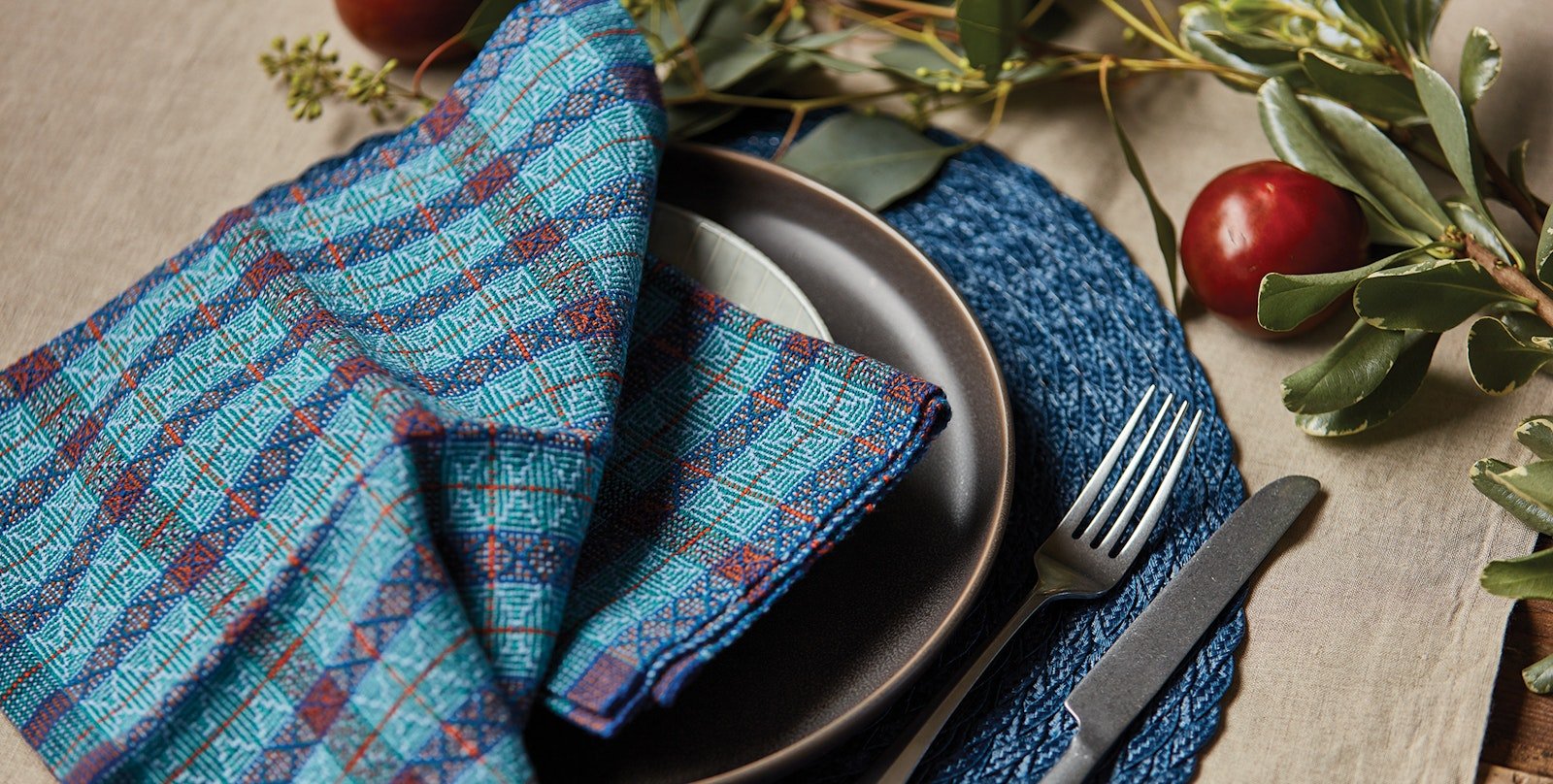Mary Meigs Atwater introduced shadow weave in the early 1940s. Because she got the idea from warp rep, she threaded it the same way. In warp rep, two colors alternate on shafts as far away from each other as possible (shaft 1 with 3 and shaft 2 with 4) to make the dense warp threads easier to open.
The overall structure of shadow weave is plain weave with short 2-thread skips in both the warp and weft directions where vertical and horizontal lines meet. In the Atwater version, a dark thread on shaft 1 is followed by a light (“shadow”) thread on shaft 3, dark on 2 by light on 4, dark on 3 by light on 1, and dark on 4 by light on 2. Designing is most often done by threading the dark threads in a twill, starting on shaft 1, say, with each dark thread followed by a light thread using the same twill but starting on shaft 3 (see Clotilde Barrett in Resources or Introduction to Shadow Weave for design techniques using the Atwater system).
The Powell Method
In the 1970s, Marion Powell recognized shadow weave as a block weave. In block weaves, the same warp and weft threads make two different-looking interlacements, one we identify as pattern and one as background. She determined that in shadow weave, the blocks forming horizontal lines (which “move the eye more readily”) should be considered pattern, and the blocks forming vertical lines should be considered background.
To use shadow weave with profile drafts, Powell changed Atwater’s threading so that dark threads are followed by light threads on adjacent shafts. Block A becomes dark on 1, light on 2; Block B, dark on 3, light on 4; Block C, dark on 4, light on 3; Block D, dark on 2, light on 1. Figures 1 and 2 show two 4-block shadow-weave drafts featured in projects in this issue of Handwoven that use the Powell method (one draft for Margie Bell’s ruana and one for Nancy Rimsha’s scarf).
8-shaft drafts
In the drafts in Figures 1 and 2 (and in all 4-shaft, 4-block shadow weave), blocks weave “two by two”: two blocks produce vertical lines and two blocks produce horizontal lines throughout. The blocks producing horizontal lines (i.e., pattern, per Powell) are shown at the right of the treadling drafts in Figures 1 and 2.

1. 4-shaft, 4-block shadow weave

2. 4-shaft, 4-block shadow weave
On eight shafts, four blocks can be threaded and woven independently. In Figure 4, a dark thread on an odd shaft alternates with a light thread on an even shaft in each block. Blocks A, B, C, and D can each weave pattern (horizontal lines) alone. Any block can be changed from producing horizontal lines to vertical lines or vice versa by reversing the treadling order of its respective pair of shafts. The shafts highlighted in the tie-up in Figure 4 show the positions of the two shafts that produce horizontal lines in each block.

3. 8-shaft, 8-block shadow weave
Eight blocks can be woven on eight shafts by reversing the threading order of each block pair for four more blocks (dark on shaft 2, light on shaft 1 for Block E, dark on shaft 4, light on shaft 3 for Block F, etc.). In this case, Block A will always show lines in the opposite direction from Block E, B from F, C from G, and D from H. Four blocks produce vertical lines and four blocks produce horizontal lines throughout.

4. The draft in Figure 2 expanded to eight shafts
The draft in Figure 3 is the 8-shaft, 8-block draft used for Jan Barbieri’s napkins in this issue. The drawdown doesn’t shout “block weaves” because block size is so small (two or four threads each). In the tie-up, the odd/even order of the shafts causes vertical lines in one of the blocks using that pair of shafts but horizontal lines in the other. Designing can become fairly complex, and a computer weaving program is very helpful. Powell’s book, although sadly out of print, is a rich source for complete drafts in 4-, 6-, and 8-shaft shadow weave created from 4-, 6-, and 8-block profile drafts.
Resources
- Atwater, Mary Meigs. Shuttle-Craft Guild Bulletin. Basin, Montana, February 1942 (introduces shadow weave).
- Barrett, Clotilde, Shadow Weave and Corkscrew Weave. Boulder, Colorado: Colorado Fiber Center, 1980.
- Powell, Marian. 1000(+) Patterns in 4, 6, and 8 Harness Shadow Weaves. McMinnville, Oregon: Robin and Russ Handweavers, 1976.

